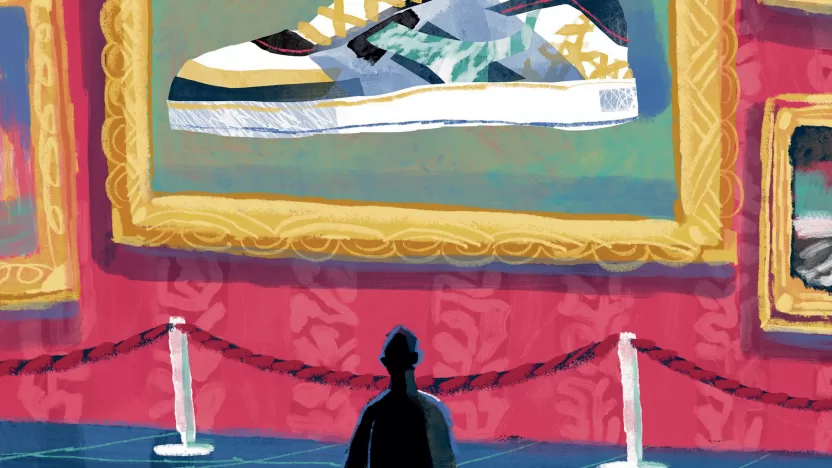Embracing complexity
The world is increasingly more complex, and so are its challenges, writes Christian Schneider. But strategic design can be an immensely helpful tool to navigate these uncharted waters
by Christian Schneider

Strategic design is a continuously evolving practice that aims to unveil opportunities, evolve new concepts, and strategize paths towards implementation. Since designers started to play with new technologies to create web-based, mobile, and computing applications for our lives and work, the spectrum of design interventions has increased dramatically.
There are numerous success stories, and it hasn’t just been the way designers think that made them happen, but the way designers bring together and orchestrate a variety of disciplines to find new solutions. The tech products we had been working on starting in the early nineties had no precedents. We needed human factors, anthropologists, and psychologists to evaluate the impact of new functions and possibilities.
We also pushed to overcome isolated roles when working with engineering, marketing, and sales, as the input from all these departments has been crucial for the design of product service systems. The spectrum of design interventions increased, so did the range of contributors as we design for social innovation, organizational structures, and systems.
Our challenges are complex – we need to integrate a wide range of perspectives to find new solutions and opportunities. We continue to learn how to build and guide collaboration, as we know what can happen if we bring different expertise, experiences, thought, and behavior patterns together: new solutions come to light that nobody could have anticipated beforehand, in isolation.
One of the rules that describe a framework for our collaborative spaces in my project courses in academia and projects I lead for clients is that we never start a sentence with the words “I think”. Brainstorming, for instance, is not for you to come up with a great idea. It is about engaging with others to come up with great ideas. We want to make maximum use of a possibly heterogeneous group. The success of our work depends on our capacity to engage, to bring together, to come across the unexpected.
What makes design research different from other research methods is that we do not work towards assumptions, ideas, or visions. It is quite the opposite. We apply tools to understand or illuminate an area that is in need of innovation, but what the directions and opportunities are we will know at the end of the process. We open up constantly throughout this process, and do not narrow down.
As soon as we have a contribution, we challenge it and move on. We do not judge or decide; we aim to cover everything that could be done and place it on a map. Inputs from the team, other departments, external voices from experts, stakeholders, and of course the target group, people who participate in open conversations, workshops, and online engagements. We do not exclude anything; we play with this complex structure of possible solutions and leads.
While creating a variety of arrangements and thematic clusters, showing synergies and scales, we will see new structures take form. We will also see a core, a center, that connects to all ideas and possible project leads on this map: this center is the purpose of our project. While many of the parts on this map will evolve into functions of the overall project, this possibly simple and clear description of a complex body will guide all further developments.
Complexity’s best friend is simplicity. There is no simplicity if we do not cover the complexity. The spectrum of the nuances is endless if the central message is simple.
Systemic interventions, living systems
Everything we design is embedded in a wider network. The better we understand the network, the better we can design our part. With the increasing complexity of basically anything that conditions our economies and societies, there are no final and complete solutions.
Everything we do is a contribution to greater systems. Nothing exists in isolation. The only constant is change. Our designs are successful if they are systemic interventions that, if they recognize and understand the system, will be part of and contribute to the values, qualities, and purposes those systems should satisfy. Design for living systems requires gradual interventions and flexible models.
Most structures, organizations, and corporations, however, function like machines. They lack the adaptability and the capacity to respond to complexity and uncertainty. It is a strategic design challenge to understand the functioning of these structures, bring together competencies, build on various perspectives, define, and visualize scaled transformation processes.
Complexity’s best friend is simplicity. There is no simplicity if we do not cover the complexity. The spectrum of the nuances is endless if the central message is simple.
Ideas, talent, and technology
Many of our challenges, whether in corporations, groups, or societies will not be solved by technology only. For instance, technology made social media possible, but how we use these platforms is a longer, much more complex process. It is not a technology, one idea or solution that will enable sustaining change. Any change process is guided by a range of activities that together should satisfy the purpose and scope of a project.
Guidelines for a smart, efficient, and sustainable integration of technologies are, however, more tangible than principles to motivate people, lead and monitor development, and change processes. We need to define parameters for the scope of our work, the values it should represent, and a culture code of how we work together. This framework should enable a free space that allows individual contributions.
In the end, it is not a co-worker’s talent that counts, but room for expression. We need to make sure that we hear and consider all voices, not just the loudest. It will be the responsibilities of the various stakeholders that weigh in when it comes to decision-making, but also the shared mandate and agency of all those involved that enables the outcome of a task and, finally, the whole project. It is a balance of framework and leeway that creates efficient, high-quality work.

Organizational challenges: industry, education, policy
The automotive industry will continue to develop always better cars. Technology responds to sustainability, and electric vehicles appear as cleaner transportation for individuals. However, it might be social and urban development that determines the future success of the car business, both areas that this legacy industry is not well-versed in. Innovation hubs explore new approaches, so do finance startups.
The necessary internal change process to innovate does not happen with external inputs, though, as they are not an integrative part of the organizational structure. Besides transportation, the financial and healthcare industries have also used design thinking to innovate beyond digital transformation and web-based service offerings. The need to innovate is obvious, the potential infinite, but they are yet to integrate this kind of understanding in their organizational structures.
Academia, as well as primary and secondary education, are disrupted by initiatives from groups and corporations around the globe that innovate pedagogy and curricula and increase access to education. The format of an exclusive island, in the US due to exorbitant costs, does not serve the needs of evolving societies and economies.
Most administrative roles are executed by faculty that has been part of a university for a long time. Besides theoretical understanding, the translation into practice — to make things happen, to plan and strategize internal change — is not really part of academic ecosystems.
Our most burning challenges — sustainability, immigration, and equality — require structures, solutions, and approaches that need to be redesigned, strategized, and implemented. We are not in a situation where we just need to design for sustainability; we need to deal with radically new conditions. Cultural knowledge is precious here, whether it is survival in diverse climates or simply ways to create communities and commonality, much of what western cultures have lost.
If we recognize and integrate diverse cultural content, values, and knowledge, we can better design for our social, environmental, and economic needs, better address the complexity of our burning issues. The communication of different approaches is reciprocal enrichment, mutual engagement, and catalyzation. Diversity is a prerequisite and driver for innovation.
To break down barriers and evolve approaches to bring this outstanding contribution to light and connect it with the other members, technically and personally, is the art of leading innovation processes with a design approach.
A way to lead
I have been mentoring design processes for Fortune 100 companies, SMEs, startups, students, and executives for over two decades. The approach’s forte is also its dilemma – it evolves very fast, and once we understand how to communicate it, we have already moved on. It has been intellectualized, but it is hard to assimilate if one is not experienced.
Working in strategic design does create a certain mindset, though: I treat every project as new and never experienced before. Any project, even if well established, is a continuous prototype. It is best to approach it as if I would do it the first time as there are no preconceptions or categorizations that would work against a fresh approach.
Strategic design is a way to lead and not to manage. You need to allow and love complexity. How much can you afford, where is the border to chaos and confusion? You must balance this work with frameworks, discipline, and rhythm. You need to seed, engage, push, motivate. It is like filling a bucket: at some point, something appears, the input takes shape.
It is a brief appearance, and you need to grasp it when it seems clear, simple. There is some sort of magic when a concept takes shape, or when decisions feel natural after strategic design work has been done.
Everybody has a unique perspective to share, from the expertise or experience a person has to offer. To break down barriers and evolve approaches to bring this outstanding contribution to light and connect it with the other members, technically and personally, is the art of leading innovation processes with a design approach. It is immensely satisfying to see others take off, to see an executive smile with a new trust in endeavors that have enormous responsibilities for them, and students getting passionate about their own and their peers’ projects.
Having worked for big, global players like IDEO and Parsons, I realize that the world has turned around and will evolve further bottom-up. There are brilliant initiatives all over the planet, all together with more innovation potential and new thoughts than the leading “best”. To connect and to integrate initiatives from non-established countries and economies can be for the benefit of all if we maintain autonomy and independence, and support them from where they come.
Besides the ethical responsibility, there is no benefit for anyone to flatten all input by adapting it into established systems. Also, we need to allow for complexity and see the complete picture of initiatives that work on common challenges. If a variety of inputs and solutions are shared in a non-competing way, new forms that bear new solutions for global challenges will take shape. Innovation culture should have no borders.


